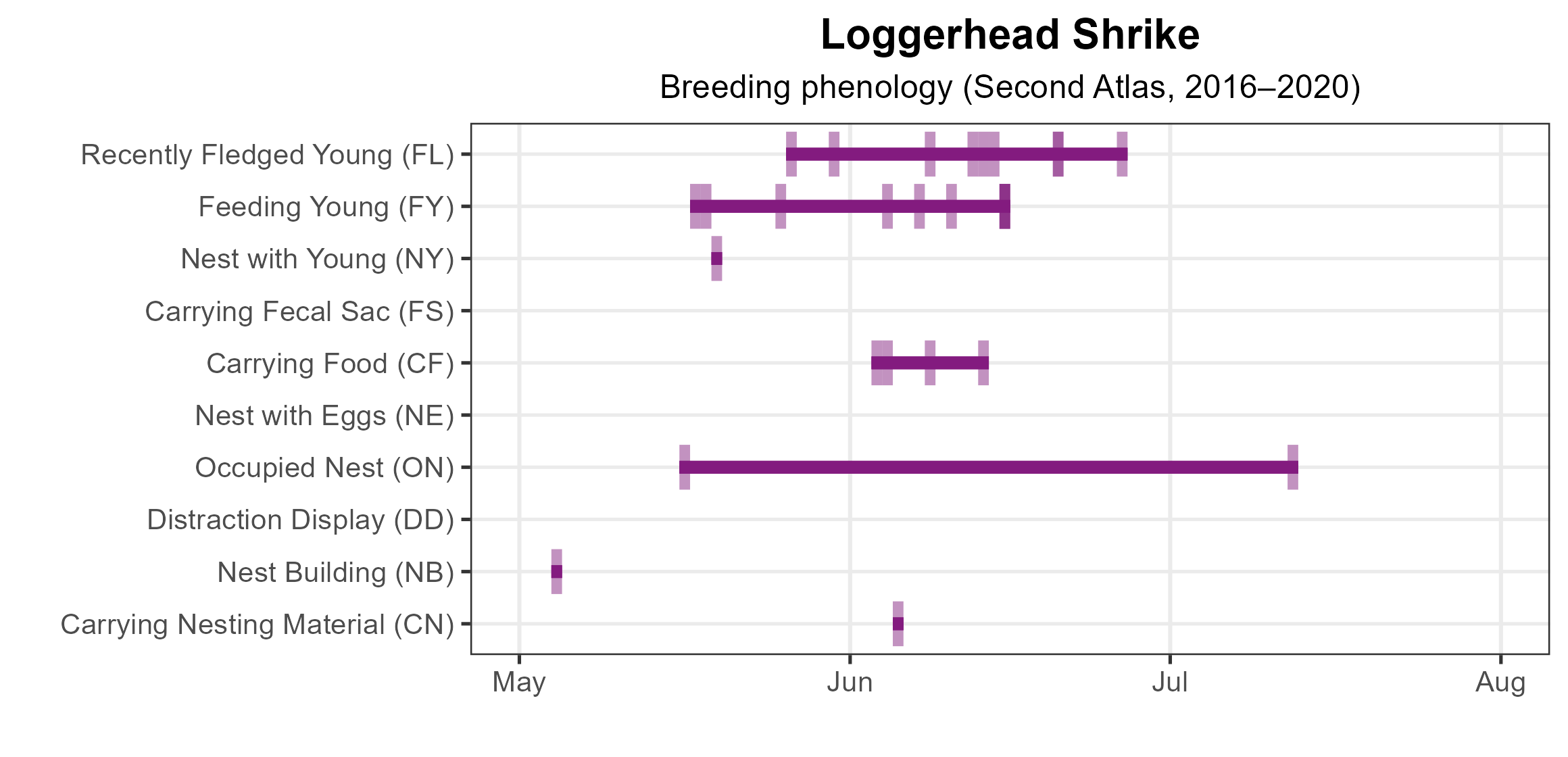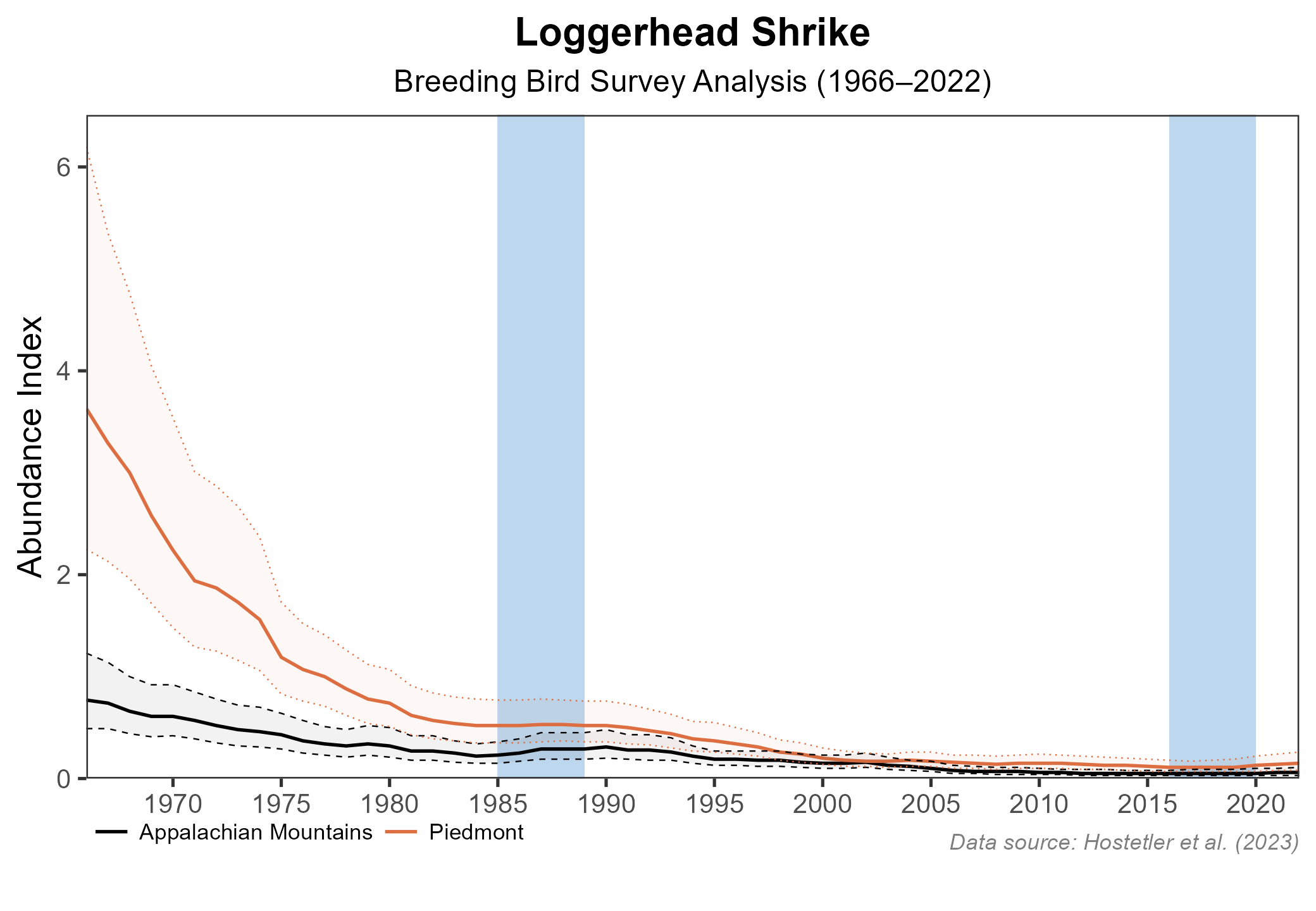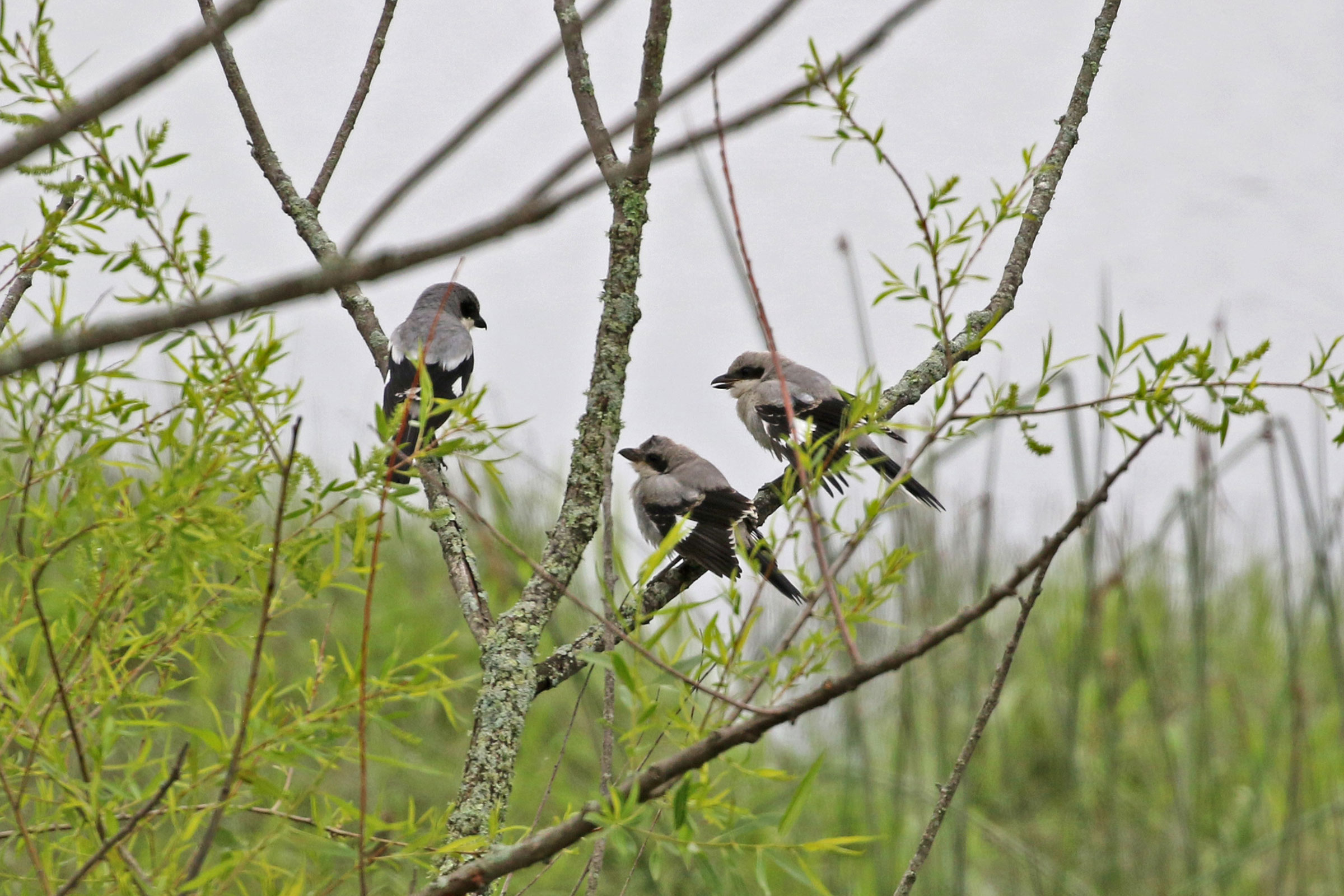Introduction
The Loggerhead Shrike is a striking, big-headed bird of open habitats. Also known as the butcher bird for its carnivorous habits, it behaves more like a bird of prey than a songbird, hunting small mammals, amphibians, reptiles, and birds in addition to insects. The Shrike’s larders, consisting of prey impaled on barbed wire or thorns, serve as food storage throughout its territory.
In Virginia, its habitat consists primarily of grazed pastures with sufficient hunting perches and with trees or shrubs for breeding, where it prefers to nest in eastern red cedar (Juniperus virginiana) and hawthorn (Crataegus spp.) (Luukkonen 1987). Its populations have plummeted since the 1970s, and it is now rare to uncommon in the Commonwealth.
Recent genetics analysis has determined that three subspecies breed in Virginia (Amy Chabot, unpublished data), and the state’s population includes both year-round residents and migratory individuals (Virginia Department of Wildlife Resources, unpublished data). Intensive efforts to track populations, uncover the causes of decline, and conserve the species are underway in Virginia.
Breeding Distribution
Virginia sits at the northeastern edge of the Loggerhead Shrike’s breeding range within the U. S. The Loggerhead Shrike is more likely to be found in the Piedmont and Mountains and Valleys regions (Figure 1), specifically in areas of the northern Piedmont region and northwestern Virginia, in the Shenandoah Valley, and in agricultural valleys in southwestern Virginia. The likelihood of a Loggerhead Shrike occurring in an area increases in blocks dominated by agricultural habitats, which include pastures. Overall, the model’s predictive power is low, estimating at best only a 15% chance that the species will occur in any given block.
The Loggerhead Shrike’s distribution during the First Atlas and its change between the two Atlas periods could not be modeled (see Interpreting Species Accounts). For more information on where it occurred during the First Atlas, please see the Breeding Evidence section.

Figure 1: Loggerhead Shrike breeding distribution based on probability of occurrence (Second Atlas, 2016–2020). This map indicates the probability that this species will occur in an Atlas block (an approximately 10 mi2 [26 km2] survey unit) based on environmental (including habitat) factors and after adjusting for the probability of detection (variation in survey effort among blocks). Blocks in gray lie outside the species' core range and were not modeled.
Breeding Evidence
Loggerhead Shrikes were confirmed breeders in just 17 blocks and nine counties and probable breeders in three additional counties (Figure 2). Breeding evidence was concentrated in the Mountains and Valleys and Piedmont regions. In the northern Mountains and Valleys region, breeding was confirmed along the West Virginia border north of Berryville (Clarke County) and north of Winchester (Frederick County). In the southwestern Mountains and Valleys region, Loggerhead Shrikes were confirmed breeding west of Radford (Pulaski County) and in multiple locations in Russell, Smyth, and Washington Counties. In the southern Piedmont region, breeding was confirmed in Lunenburg and Mecklenburg Counties. Breeding in the Coastal Plain was documented at a single location in Isle of Wight County.
In the First Atlas, breeding confirmations were more widespread (Figure 3) and included a concentration of records in the Shenandoah Valley, where the species is now found only occasionally.
Although the earliest confirmed breeding behavior was nest building documented on May 4, Loggerhead Shrikes begin nest building in April (Luukkonen 1987). Individuals were reported occupying nests, which indicates incubation and brooding, from May 16 to July 12 (Figure 4). Most breeding confirmations came from observations of adults feeding young or of fledglings. For more general information on the breeding habits of the Loggerhead Shrike, please refer to All About Birds.

Figure 2: Loggerhead Shrike breeding observations from the Second Atlas (2016–2020). The colored boxes illustrate Atlas blocks (approximately 10 mi2 [26 km2] survey units) where the species was detected. The colors show the highest breeding category recorded in a block. The numbers within the colors in the legend correspond to the number of blocks with that breeding evidence category.

Figure 3: Loggerhead Shrike breeding observations from the First Atlas (1985–1989). The colored boxes illustrate Atlas blocks (approximately 10 mi2 [26 km2] survey units) where the species was detected. The colors show the highest breeding category recorded in a block. The numbers within the colors in the legend correspond to the number of blocks with that breeding evidence category.

Figure 4: Loggerhead Shrike phenology: confirmed breeding codes. This graph shows a timeline of confirmed breeding behaviors. Tick marks represent individual observations of the behavior.
Population Status
The abundance of Loggerhead Shrikes could not be modeled from Atlas point count data because the species is not reliably detected using that survey methodology. The North American Breeding Bird Survey (BBS) no longer consistently documents the species in Virginia.
However, BBS regional trends showed a significant decrease of 5.53% per year in the Piedmont region and a significant decrease of 4.47% per year in the Appalachian Mountains region from 1966–2022 (Hostetler et al. 2023; Figure 5). Between the First and Second Atlases (from 1987–2018), BBS data showed a significant decrease of 5.0% per year in the Piedmont region and 5.38% in the Appalachian Mountains region. These declines are mirrored across the species’ range.

Figure 5: Loggerhead Shrike population trend for the Appalachian Mountains and Piedmont as estimated by the North American Breeding Bird Survey. The vertical axis shows species abundance; the horizontal axis shows the year. The solid line indicates the estimated population trend; there is a 97.5% probability that the true population trend falls between the dashed lines. The shaded bars indicate the First and Second Atlas periods.
Conservation
The Loggerhead Shrike is designated a State Threatened species and is classified as a Tier I (Critical Conservation Need) Species of Greatest Conservation Need in the 2025 Virginia Wildlife Action Plan, based on its small, declining population (VDWR 2025). Loggerhead Shrikes are in decline across much of North America. Virginia is the northeastern stronghold for the species, as breeding populations in New England have been largely extirpated. A remnant breeding population supported by releases of captively bred birds is found further north in Ontario, Canada. Virginia contributes to these efforts through the translocation of birds bred at the Smithsonian Conservation Biology Institute in Front Royal. The shrike connection between Ontario and Virginia runs even deeper, as birds from the Canadian province have been documented migrating through and even wintering in the Commonwealth (Sergio Harding, personal communication).
Conversion of forest to farmland may have contributed to Loggerhead Shrikes becoming widely distributed before the turn of the 20th century (Yosef 2020). The species is thought to have expanded into the northeastern U. S. during this period and to have peaked in abundance by the 1940s or 1950s before undergoing a rapid decline (Wilson and Watts 2012). Pesticides, particularly now-banned organochlorines such as DDT and dieldrin, may have played an initial role in these losses (Yosef 2020). The loss and degradation of habitat, including unimproved pasturelands, may have further contributed. However, much suitable habitat remains unoccupied in Virginia, leaving the cause of more recent declines unclear.
In 2013, the Virginia Department of Wildlife Resources (VDWR) was a founding member of the Loggerhead Shrike Working Group, which coordinates research and conservation for the species across the eastern U. S. and Canada. VDWR and its partners are participating in a collaborative multi-state banding and monitoring project through the Working Group. This has generated valuable data on Loggerhead Shrike genetics, seasonal movements, and ecology during the breeding and winter seasons, and to the creation of a Conservation Strategy for the Eastern Loggerhead Shrike.
Interactive Map
The interactive map contains up to six Atlas layers (probability of occurrence for the First and Second Atlases, change in probability of occurrence between Atlases, breeding evidence for the First and Second Atlases, and abundance for the Second Atlas) that can be viewed one at a time. To view an Atlas map layer, mouse over the layer box in the upper left. County lines and physiographic regional boundaries (Mountains and Valleys, Piedmont, and Coastal Plain) can be turned on and off by checking or unchecking the box below the layer box. Within the map window, users can hover on a block to see its value for each layer and pan and zoom to see roads, towns, and other features of interest that are visible beneath a selected layer.
View Interactive Map in Full Screen
References
Hostetler, J. A., J. R. Sauer, J. E. Hines, D. Ziolkowski, and M. Lutmerding (2023). The North American breeding bird survey, analysis results 1966–2022. U.S. Geological Survey, Laurel, MD, USA. https://doi.org/10.5066/P9SC7T11.
Luukkonen, D. R. (1987). Status and breeding ecology of the Loggerhead Shrike in Virginia. Master’s Thesis, Virginia Polytechnic Institute and State University. Blacksburg, VA, USA.
Virginia Department of Wildlife Resources (VDWR) (2025). Virginia wildlife action plan. Virginia Department of Wildlife Resources, Henrico, VA, USA. 506 pp.
Wilson, M. D., and B. D. Watts (2012). The Virginia avian heritage project: A report to summarize the Virginia avian heritage database. Center for Conservation Biology Technical Report Series, CCBTR 12-04. College of William and Mary and Virginia Commonwealth University. Williamsburg, VA. 48 pp.
Yosef, R. (2020). Loggerhead Shrike (Lanius ludovicianus), version 1.0. In Birds of the World (A. F. Poole and F. B. Gill, Editors), Cornell Lab of Ornithology, Ithaca, NY, USA. https://doi.org/10.2173/bow.logshr.01.





